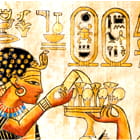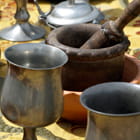Carl e-mailed to note a recipe and ask some questions. The recipe is from 30 Minutes Meals and is for Sweet and Spicy Chicken:
- 1 pound chicken thighs cut into 1 inch chunks
- 1/3 cup cornstarch
- oil for frying
- 6 cloves garlic minced
- 1 tablespoon ginger minced
- 1 teaspoon red chili flakes
- 3 dried red peppers optional
- 6 tablespoons rice vinegar
- 6 tablespoons soy sauce
- 1 teaspoons hot sauce
- 1/2 cup water
- 4 tablespoons brown sugar
- 1 tablespoon cornstarch
-
In a large bowl, toss the chicken thighs with the cornstarch well so every chicken piece is covered in cornstarch. Set aside.
-
Add all the "Sauce" ingredients to a bowl and whisk together to combine. Set aside.
-
Add vegetable oil to a large pan, at least so it reaches the mid of the pan.
-
Once the oil is hot, add the chicken and fry on medium-high heat until crispy and golden.
-
Remove chicken from the pan, save one tablespoon of oil and discard the rest.
-
Add garlic, ginger and red pepper flakes to the pan and cook on low heat for about 30 seconds, until you smell the garlic. Stir continuously and be careful as the garlic and red pepper flakes can burn quickly.
-
Add in the chicken back to the pan and toss.
-
Give the sauce a quick stir and add it to the pan.
-
Stir to coat well the chicken for about 30 seconds to 1 minute, until sauce has thickened.
-
Serve immediately with rice.
Carl notes that he's just started cooking and when he makes the recipe above, he uses whole chicken thighs. If it works for you, it's great.
Questions? Carl asks on an average day what do I eat?
I'll deal with today.
I had two cups of coffee when I woke up. I didn't go to work today (off). I skipped breakfast because I just didn't feel like eating. Later, I had a small bowl of black eyed peas.
As I've noted before, on weekends, there's always a pot of something on the stove during the day. Especially in the winter, it'll be two or more pots throughout the day. But it's beans or peas or lentils. They're inexpensive and that mattered when we were raising eight kids. They're also full of fiber and good for you. So the kids would come in when they were little wanting a snack on Saturday between playing and that's what they'd get -- a bowl of beans, peas or lentils. Now we've got grandkids and I've continued the tradition because if I ever didn't do it, I'd hear, "What's wrong?"
So I presoak a bag of dried beans, peas or lentils on Friday (I presoak two in the winter) and cook them on the stove on Saturday (and presoak on Saturday for Sunday). Sometimes, after presoaking and rinsing (and you don't have to presoak lentils, but I usually do), I'll cook them without anything extra. Sometimes, I'll add a summer sausage or carrots or onions or celery or mushrooms.
I do season them while they're cooking and I'll come back to that in a moment.
Before sitting down to write, I had a bowl of gumbo with wild rice.
I made the gumbo today.
So my vegetables for the day -- Carl asked -- would be black-eyed peas, tomatoes (crushed -- in the gumbo), okra (in the gumbo), corn (in the gumbo), onions (diced, in the gumbo), bell pepper (diced, in the gumbo). Fiber? Black-eye peas and the wild rice. At some point, I'll probably have some popcorn. My kids are watching a Grace and Frankie marathon on E! and after that's over, I think another hour, we're all going to watch a movie so we'll have popcorn then.
Carl asks how important is seasoning to cooking?
Very.
Now a fresh peach is perfection. But most foods do need to be seasoned.
You don't have to use fresh or dry spices. You could cook chicken or fish or vegetables with some lemon slices for seasoning, for example. Onions are required in a lot of recipes and they impact the taste of the food. If you're cooking a Cajun or Creole recipe, you're using "the holy trinity" -- carrots, onions and celery. Garlic -- crushed, chopped, sliced, etc -- also seasons dishes.
If you're limited in space -- Carl's problem -- you can still keep a few spices on hand. Pepper and salt are spices. In addition, I couldn't live without cumin -- which I add to most meat dishes and most Mexican dishes. But figure out some spices you use and keep them on hand. It doesn't have to be thirty or even ten. Chili powder, paprika, garlic powder and onion powder are some to consider.
We (humans) have been seasoning our food for some time and, Carl, you e-mail makes me want to find a book about the history of spices. But for now, let me note this:
History of Spices
- Emperor Charlemagne (AD 742-814)
Early Humans

Abundant anecdotal information documents the historical use of herbs and spices for their health benefits (1). Beginning 6 million years ago, early man co-evolved with the flowering plants in the world around him (2). Early documentation suggests that hunters and gatherers wrapped meat in the leaves of bushes, accidentally discovering that this process enhanced the taste of the meat, as did certain nuts, seeds, berries, and bark. Over the years, spices and herbs were used for medicinal purposes. They were also used as a way to mask unpleasant tastes and odors of food, and later, to keep food fresh (3). Ancient civilizations did not distinguish between those spices and herbs used for flavoring from those used for medicinal purposes. When leaves, seeds, roots, or gums had a pleasant taste or agreeable odor, they became in demand and gradually became a norm for that culture as a flavor enhancer.
Biblical Times
From the dawn of biblical times (17th century BC), spices were prized for a wide variety of uses including religious offerings, burial rituals, medicines, trade, and seasoning. Spices are mentioned numerous times throughout the Bible. In the Song of Solomon, several culinary spices are mentioned including cinnamon and saffron (2). In 1000 BC, Queen Sheba visited King Solomon in Jerusalem and offered him "120 measures of gold, many spices, and precious stones" (2 Chronicles 9:9). The people of Israel described manna bread as being “white like coriander seeds” (Exodus 16:31). The New Testament refers to a religious tithing of “a tenth of your spices - mint, dill, and cumin” (Matthew 23:23) and spices were described as anointing the body of Jesus (Mark 16:1).
Ancient Egypt

A summary of ancient Egyptian medical practices, the Ebers Papryus (1500 BC), cited medical treatments consisting of caraway, coriander, fennel, garlic, mint, onion, peppermint, poppy, and onion (4). Onion and garlic were of particular importance. Laborers who constructed the Great Pyramid of Cheops consumed onion and garlic to promote health as well as stamina and garlic cloves were found in the tomb of King Tutankhamen. Some ancient Egyptians even placed wooden figures of garlic cloves in their tombs to ensure a tasty and wholesome afterlife. The Egyptians also enjoyed flavoring their food with cardamom and cinnamon which they sourced from Ethiopia (3).
Early Chinese Influence
According to ancient myths, Shen Nung likely wrote Pen Ts’ao Ching (The Classic Herbal) around 2700 BC. The early publication mentioned more than a hundred medicinal plants including the spice cassia, which is similar to cinnamon (called “kwei”). A later, more comprehensive Chinese herbal, Pen Ts’ao Kang Mu was published in 1596 BC by Li Shih Chen. Other historical evidence suggested that cassia was an important spice in South China when the province Kweilin, meaning "Cassia Forest", was founded around 216 BC.
Early on, nutmeg and cloves from Moluccas were brought to China. Anecdotal evidence suggests that Chinese courtiers in the 3rd century BC carried cloves in their mouths so their breath was sweet when addressing the emperor. During the 5th century AD, ginger plants were grown in pots and carried on long sea voyages between China and Southeast Asia to provide fresh food and to prevent scurvy.
Ancient Mesopotamia

Ancient cuneiform records noted spice and herb use in Mesopotamia in the fertile Tigris and Euphrates valleys, where many aromatic plants were known. Sumerian clay tablets of medical literature dating from the 3rd millennium BC mention various odoriferous plants, including thyme. A scroll of cuneiform writing, established by King Ashurbanipal of Assyria (668-633 BC), records a long list of aromatic plants, such as thyme, sesame, cardamom, turmeric, saffron, poppy, garlic, cumin, anise, coriander, silphium, dill, and myrrh. The ancient Assyrians also used sesame as a vegetable oil.
King Merodach-Baladan II (721-710 BC) of Babylonia grew 64 different species of plants in his royal garden. He kept records on how to cultivate many spices and herbs such as cardamom, coriander, garlic, thyme, saffron, and turmeric. The religion of Babylonia involved an ancient medical god of the moon, who controlled medicinal plants. Potent parts of herbs were not allowed sun exposure and were harvested by moonlight.
Onions, garlic, and shallots became popular condiments in Persia by the 6th century BC. Records from King Cyrus (559-529 BC) noted a wholesale purchase of 395,000 bunches of garlic. Persians also produced essential oils from roses, lilies, coriander, and saffron.
Indian Origins
Spices and herbs such as black pepper, cinnamon, turmeric, and cardamom have been used by Indians for thousands of years for both culinary and health purposes. Spices indigenous to India (such as cardamom and turmeric) were cultivated as early as the 8th century BC in the gardens of Babylon (2).
Sushruta, an ancient surgeon (around 4th century BC), used white mustard and other aromatic plants in bed sheets to ward off malignant spirits. He also applied a poultice from sesame to postoperative wounds which may have acted as an antiseptic.
Medical writings of Charaka (1st century) and Sushruta II (2nd century) referenced spices and herbs. Sushruta II also used spices and herbs such as cinnamon, cardamom, ginger, turmeric, and pepper for healing purposes. Spices such as cardamom, ginger, black pepper, cumin, and mustard seed were included in ancient herbal medicines for different types of health benefits. In Ayurvedic medicine, spices such as cloves and cardamom were wrapped in betel-nut leaves and chewed after meals to increase the flow of saliva and aid digestion.
Ancient Greece and Rome

Ancient Greeks imported Eastern spices (such as pepper, cassia, cinnamon, and ginger) to the Mediterranean area. They also consumed many spices produced in neighboring countries. Examples include caraway and poppy seeds for bread, fennel for vinegar sauces, coriander as a condiment in food and wine, and mint as a flavoring in meat sauces. Garlic was widely used by the country people in much of their cooking. Ancient Greeks wore parsley and marjoram as a crown at their feasts in an attempt to prevent drunkenness.
Spices and herbs played an important role in ancient Greek medical science. Hippocrates (460-377 BC), wrote about spices and herbs, including saffron, cinnamon, thyme, coriander, mint, and marjoram. He noted that great care should be given to the preparation of herbs for medical use. Of the 400 herbal remedies utilized by Hippocrates, at least half are in use today. Roughly 500 years later, Theophrastus (372-287 BC), sometimes called the "Father of Botany," wrote 2 books that summarized the knowledge of over 600 spices and herbs.
The Greek Physician Dioscorides (AD 40–90), wrote De Materia Medica, which was used for botany and medicinal knowledge in both the East and the West for over 1500 years. The remedies were based on an extensive catalogue of spices and herbs and were more systematic than his predecessors who based their remedies on magic and superstition.
The Romans were extravagant users of spices and herbs. Spice-flavored wines were used in ancient Rome and spice-scented balms and oils were popular for use after the bath. Since spices were considered to have health properties, they were also used in poultices and healing plasters.
When the Roman Empire extended to the northern side of the Alps, the Goths, Vandals, and Huns of those regions were introduced to pepper and other spices from the East. These cultures were familiar with caraway, onions, rosemary, and thyme and gradually became attracted to the Eastern spices.
Arab and Muslim Influence
Medieval Europe

In the early part of the middle ages (before the Crusades), Asian spices in Europe were costly and mainly used by the wealthy. A pound of saffron cost the same as a horse; a pound of ginger, as much as a sheep; 2 pounds of mace as much as a cow. A Germanic price table of AD 1393 lists a pound of nutmeg as worth 7 fat oxen.
Black pepper, as well as other spices and herbs, was commonly used as a monetary source. Eastern Europeans paid 10 pounds of pepper in order to gain access to trading with London merchants. Throughout Europe, individual peppercorns were accepted as currency to pay taxes, tolls and rents (partly because of a coin shortage). Many European towns kept their accounts in pepper. Wealthy brides received pepper as a dowry and some landlords would get paid in “peppercorn rent” (2).
With the coming of the Crusades (AD 1095-1492), international exchange of goods became common. Gradually, Asian spices such as pepper, nutmeg, cloves, and cardamom became less expensive and more widely available. Spices were used to camouflage bad flavors and odors, and for their health benefits. Spiced wines were also popular.
European apothecaries used Asian spices (such as ginger, pepper, nutmeg, cinnamon, saffron, and cardamom) as well as garden herbs in their remedies and elixirs. The remedies were largely based on Arabian medical teaching.
An important person in developing and growing local herbs was the King of France and Emperor of the West, Charlemagne (AD 742-814). He was the first leader to have farmers plant an abundance of culinary herbs such as anise, fennel, fenugreek, and sage, thyme, parsley, and coriander.
European cultivation of spices and herbs was largely controlled by the church during this period. Religious spice and herb feasts were common. Some ancient customs and superstitions (such as tying bundles of herbs to stable doors to keep the witches out) were also continued.
In AD 1180, King Henry II founded a "pepperer’s guild" of wholesale merchants, which was a predecessor to the modern day grocery store. The guild included spice trade management, which included cleaning and preparing the spices for sale. The original spicers and pepperers helped launch the apothecaries and later became medical practitioners. Some common medical practices included placing sponges soaked with cinnamon and clove extracts under patients noses, sterilizing rooms with sage smoke, and prescribing saffron, garlic soup, and juniper wine for health benefits.
Age of Exploration

Marco Polo mentioned spices frequently in his travel memoirs (around AD 1298). He described the flavor of the sesame oil of Afghanistan and the plants of ginger and cassia of Kain-du (the city of Peking), where people drank a flavorful wine of rice and spices. He reported that the wealthy in Karazan ate meat pickled in salt and flavored with spices, while the poor had to be content with hash steeped in garlic. He mentioned that in Hangchow, 10,000 pounds of pepper were brought into that heavily populated city every day. Polo also described vast plantings of pepper, nutmeg, cloves, and other valuable spices he had seen growing in Java and in the islands of the China Sea, and the abundance of cinnamon, pepper, and ginger on the Malabar Coast of India. Some anecdotal evidence suggests that Polo’s accounts led to an increased international spice trade during the 13th and early 14th centuries.
The ancient Mesoamerican civilizations enjoyed a rich heritage of spice and herb usage and many spices popular today were only introduced to the outside world after the European discovery of America. When Christopher Columbus set out on his second voyage (AD 1493), he brought along Spanish physician Diego Chanca, who introduced capsaicin (red pepper) and allspice to Spanish cuisine. Vanilla is another spice that is native to Mexico. It was an Aztec tradition to drink chocolate beverages with a dash of vanilla. To this day, vanilla is a common ingredient in many chocolate beverages and candies. The Badianus Manuscript (AD 1552) is the oldest herbal text from the Americas and it includes ancient Mesoamerican prescriptions for a variety of afflictions (5).
King Manual I of Portugal had a large influence on bringing spices to his country. Several sea voyages helped establish a trade route to India. By AD 1501, via the port of Lisbon, Portugal had large quantities of Indian spices such as cinnamon, cassia, ginger, pepper, nutmeg, mace, and cloves. The King sent trade missions to develop new markets for his spices throughout Europe, especially in Germany. As the spice wealth poured into Lisbon, the Portuguese crown monopolized the lucrative but risky pepper trade. Cargoes of East Indian vessels were sold at high prices by the King of Portugal to large European syndicates. As in medieval times, the price of pepper served as a barometer for European business in general.
American History

European spices were part of the food staples brought to the American colonies by early settlers. Colonists soon began incorporating indigenous spices and herbs as well. Jamestown, Virginia founder Captain John Smith (AD 1580-1631) wrote about spices, such as sassafras and onions, employed for medicinal purposes by the Native Americans (6). American colonists incorporated Sassafras as a main flavor component for root beer and it is also used in Creole cuisine (7).
After the Boston Tea Party (AD 1773), tea drinking became unpatriotic in Colonial America and spices and herbs were used to replace traditional tea. Sassafras bark, chamomile flowers, spearmint leaves, lemon balm leaves, raspberry leaves, loosestrife, goldenrod, dittany, blackberry leaves sage, and many others were often used as a beverage (8).
Toward the end of the 18th century, the United States entered the world spice trade. The British taxes and trade restrictions of colonial days no longer obstructed American commerce. They traded American salmon, codfish, tobacco, snuff, flour, soap, candles, butter, cheese, and beef, for spices such as pepper, cassia, cloves, cinnamon, and ginger.
Salem, Massachusetts enjoyed a flourishing Sumatra pepper trade and profited immensely from taxation and sales (AD 1797-1846). Most of the enormous quantities of pepper were re-exported to European ports (Stockholm, Gothenburg, Hamburg, Copenhagen, and Antwerp) or were transferred to Philadelphia, Boston, and Baltimore for processing and distribution by other American merchants and exporters. The largest single cargo on record for one of the Salem pepper fleet was of just over 1 million pounds (500 tons) of pepper, brought from Sumatra to Salem in 1806 by the Eliza, a sailing ship of 512 tons. After 1846, an overproduction of spices brought a gradual decline in its economic importance until the final demise of the Salem pepper trade following the outbreak of the Civil War in 1861 (AD 1861-1865).
War rations for American Civil War Union soldiers included cinnamon, ginger, nutmeg, and pepper. One of the most unusual uses for spices was conceived during the war. A letter found in the United States Library of Congress indicates that ground red and black peppers could be tied to a kite in a releasable bag to find its way into the eyes and noses of the Confederate Army. It should be noted that no one knows if this experiment was actually tried (8).
Modern Spice Usage

Unlike earlier times when monopolies dominated the spice trade, commerce in spices is now relatively decentralized. Throughout the world, spices and herbs are frequently used in cuisine, to improve flavor, and to provide new tastes. Spices can be found everywhere, including outer space: in 1982, spices were incorporated into astronaut food for the United States space shuttle program (9).
The information age (mid-20th century) has ushered in a new age of global cuisine sharing. Curious home cooks increasingly prepare meals from a wide range of ethnic heritages using an increasing array of spices. The United States Department of Agriculture (USDA) reports that the consumption of spices in the US has climbed exponentially over the course of the last half-century, and spices such as ginger and chili pepper are being used more frequently than ever before (10).
There is also a renewed interest in the health benefits of spices and herbs. Data from 2015 indicates that 5-10% of adults in the United States use botanical supplements such as spices, for health benefits (11). The 2020-2025 US Dietary Guidelines for Americans states that “Spices and herbs can help flavor foods when reducing added sugars, saturated fat, and sodium, and they also can add to the enjoyment of nutrient-dense foods, dishes, and meals that reflect specific cultures” (12).
One of the most promising developments for spices in modern times is that scientific evidence is accumulating that supports the anecdotal health benefits touted by our ancestors. Research shows that culinary spices and herbs may have beneficial effects in areas such as heart health, cognition, and weight management as well as improving diet quality by making healthier foods more acceptable to consumers. The body of scientific evidence is ever expanding to support the wisdom of our ancestors throughout the ages.
That's from McCormick which makes the only ground black pepper I ever buy. Let me see what else by them I have in the kitchen. I have their ground cinnamon, ground thyme, ground tumeric, their paprika, their celery salt, poppy seeds, smoked paprkia, their celery seed, their ground cumin, oninon powder and garlic powder, their minced onions,, ground mustard, again, their pepper. I trust McCormick spices to taste right. You don't always get that with all brands. I don't buy cilantro, bay leaves, basil, parsley or oregano in ground form because I've got all of those in a window in my kitchen -- my indoor spice garden.
Now for some news. Tulsi Garbage. Let me note a Tweet from that Twit:
This is C.I.'s "Iraq snapshot" for Friday:
John Rees from the Don't Extradite Assange campaign said, “This
event in the Wistaverse is a valuable opportunity to unite people
across the world who believe in freedom of speech and freedom of the
press to show their support for Julian and set a signal that will be an
important precedent for human rights everywhere. No matter where you are
in the world, you can virtually join this event.”
The
event will include the participation of and speeches by Julian Assange
himself (pre-recorded), his wife Stella Assange, Kristinn Hrafnsson, the
co-founder and editor-in-chief of WikiLeaks, and other high profile
guests, including British politician Jeremy Corbyn.
The event
will take place in the Wistaverse, the world’s first platform for
virtual protest in the metaverse. The Wistaverse is a not-for-profit
protocol located in the Sandbox on the Polygon blockchain. Users who
organize protests do so on their own initiative, independent of the
Wistaverse’s creators. The protocol enables a platform for protest for
causes with universal importance and gives access for everyone to
participate, regardless of geographical location or possible physical
disabilities.
Jules, one of the founders of Wistaverse, said: “We
are excited that the Don't Extradite Assange campaign has decided to
use the platform to host such a key rally shortly after the launch of
the Wistaverse this May. At that time, the inaugural protest was an
event organized by Amnesty International in support of abortion rights
worldwide. Now, we trust that the event this Saturday will set a signal
and focus all eyes on freedom of speech to support that cause. The new
Web3 technologies are enabling unprecedented participation and the
opportunity for everyone to shape worldwide governance.”
The
rally will take place in a virtual auditorium designed to look like the
Royal Courts of Justice in London where Assange is set to face his
final appeal in the UK court system. It aims to build for a real life
protest at the same venue when the court date is announced.
The
speakers at the rally will appear either as characters inside the event
or with filmed contributions shown on screens inside the arena created
by the event designers.
The Wistaverse uses metaverse technology to
allow each individual attendee to be represented by an avatar that can
hear the speeches and watch other material inside the virtual rally and
interact with other attendees. It protects users’ identity and enables
universal participation. The rally is open to anyone with a computer.
The rally will be on Saturday 26 August at 5pm BST/ British Summer Time, when information about how to participate will go live on the event’s dedicated website on the Sandbox.
For more information contact:
For Don’t Extradite Assange Campaign: media(at)dontextraditeassange.com or
Silvi: email: ps13(at)tuamail.com Tel.: +44-798-480-9125
For the Wistaverse: jules.wistaverse(at)gmail.com & Wistaverse(at)transformgroup.com
For details, visit: www.wistaverse.com & Dontextraditeassange.com
About Don’t Extradite Assange Campaign
The
Don’t Extradite Assange Campaign has been established in the UK by
WikiLeaks in order to focus campaigning efforts on preventing the
extradition of journalist and publisher Julian Assange to the United
States where he faces 175 years in jail. Through his publications he has
exposed war crimes against humanity, government corruption and mass
surveillance.
Visit: Dontextraditeassange.com
John Rees from the Don't Extradite Assange campaign said the benefit of holding a metaverse mass protest is that, "no matter where you are in the world, you can virtually join this event.”
He told Yahoo Finance UK's The Crypto Mile that this "first of its kind" event would not replace physical protests on the streets of major cities, but would complement the ongoing campaign.
"We have had the metaverse environment designed as a replica of the real Royal Courts of Justice, so that people attending this event will get the idea it would be a good thing to turn up outside the real court on the day that Julian appears," he said.
Rees said he is hopeful they will get thousands of people to virtually attend from across the globe.
"This is a pioneering form of political action, and if it works I'm sure we will not be the only ones to repeat it," he added.
Sceptics have wondered aloud whether a protest in an obscure corner of the internet – it uses a gaming platform called Sandbox – can have the same impact as real-world disruptive action.
“The answer to that is protest is also mainly a social event where people with a common vision get together,” one of the Wistaverse’s co-founders, Jules Alcazar, told The National.
“Having everyone together in one place is also a great opportunity to go fund-raising. It’s about keeping momentum, it’s finding what activism can do.”
He believes the metaverse also has an edge over social media activism, which is “very limited”, “not immersive” and a “very poor way of experiencing it” because its algorithms relentlessly feed back bias.
There are forecasts that the metaverse, championed by Facebook founder Mark Zuckerberg as a virtual-reality world encompassing education and health care, could one day be worth $5 trillion to $13 trillion.
‘He put out information people didn’t want being put out but it was all truthful and I don’t know how you fault a guy for putting out the truth,’ mused Kelly Slater in an Instagram soliloquy one March eve.
Just as seamless as Slater’s transitions are from the tube to the open face, so too are his analyses of complex geopolitical, health and social issues.
Typically one should have domain-specific expertise, some skin in the game, to credibly navigate these deep waters — but 11 surfing World Titles and a few compelling exchanges with high-profile pod bros works fine too in 2023.
Way less student debt too, this method. And more barrels.
Slater’s sentiments did not go unnoticed by Kym Staton — director of the forthcoming opus delving into the character assassination of WikiLeaks founder Julian Assange, who faces a 175 year prison sentence if extradited to the US for the crime of leaking classified information.
Originally titled Free The Truth: Free Assange has gracefully segued into the more enigmatic appellation, The Trust Fall. While the nomenclature may evolve, the narrative spine remains robust.
“The main aim of this film is to gather more support for Julian’s freedom. At its core, this is a political case and a mass public outcry is needed in order to pressure US, UK, and Australian politicians to do the right thing and release him,” writes Staton — whose endgame is to whip up a chorus of cheers for Assange’s parole. He’s slapping a big ol’ megaphone on this whole political mess, hoping to rile up enough people from the US, UK, and Australia to gang up on their politicians and demand, ‘Hey, do the right thing, guys! Let the man loose!’
Senator Tim Scott said the solution to the crisis in education was to “break the backs” of the teachers unions, by which he meant crushing the teachers themselves, who have engaged in massive strikes, not the stooge unions run by millionaire bureaucrats and CIA agents.
Former Governor Chris Christie said that the teachers unions were the biggest enemy of America, and boasted that he had slashed public employee pensions during his eight years in office in New Jersey.
Former Vice President Mike Pence declared that he was the only candidate willing to state openly that there had to be major cuts in Social Security and Medicare. None of the others on the stage indicated opposition to this proposal, which would devastate tens of millions of retired and disabled workers.
Florida Governor Ron DeSantis called for shooting migrants “stone cold dead” to stop them crossing the US-Mexico border, and said that he would dispatch US Special Forces into Mexico on his first day as president—in effect, the invasion of Mexico by the US military.
IT multimillionaire Vivek Ramaswamy condemned all measures taken to protect working people during the COVID-19 pandemic—effectively arguing that the current policy of letting the virus run rampant should have been adopted from Day One. And he called climate change a “hoax,” in response to a question that cited record heat waves, wildfires and unprecedented rainfall events.
+ Vivek Ramaswamy, 9/11 Truther: “I think it is legitimate to say how many police, how many federal agents, were on the planes that hit the Twin Towers. Maybe the answer is zero. It probably is zero for all I know, right?”
+ Ramaswamy has been accused of hiring someone to scrub his Wikipedia page of unflattering (to the MAGA base he is so urgently courting) biographical episodes, including his receipt of a Paul and Daisy Soros Fellowship for New Americans in 2011, as well as his role on Ohio’s COVID-19 Response Team. But his association with the son of the Dr. Mabuse of the Left hasn’t escaped the attention of the intrepid investigators at FoxNews.

+ American history according to Vivek Ramaswamy: “the US Constitution was what won us the American Revolution.” The Constitution was written in 1787, 6 years after the defeat of Cornwallis at Yorktown, 11 years after the Declaration of Independence and 12 years after the Revolution started, in 1775.
+ At the debate, DeSantis repeatedly tried to associate himself with the Navy SEAL teams in Iraq, by saying “I was with the SEALS in places like Fallujah and Ramadi.” But DeSantis wasn’t a SEAL, he was a JAG. The role of JAGS in Iraq was advise the SEALS on who they could “legally” capture, torture and kill. Or, in his own tart phrase, whose “throats they could slit.”
After California ally Laura "Lauri" Carleton was killed for displaying an LGBTQ+ Pride flag at her San Bernadino County store, Mag.Pi, the Los Angeles LGBT Center and Flags for Good announced a new banner honoring the Lake Arrowhead community member and shop owner.
“Carleton, an unwavering ally, is one of too many people who have lost their lives due to violence that targets LGBTQ+ people,” said a statement announcing the commemorative flag.
To honor Carleton’s memory and encourage allies to work for a safer community, the Center collaborated with Flags for Good to create a rainbow banner bearing the magpie symbol — after her store's name. The proceeds from sales will benefit the Lake Arrowhead LGBTQ+ Fund.
“I assure you that the Center won’t be stopping here. Right-wing extremists have brought this fight to our doorstep, and let me promise you this: we are answering their knock at our door—and we will be greeting them with the strength that our community is known for,” said CEO of the Los Angeles LGBT Center Joe Hollendoner in a press release. “I hope we can rely on you to join us in the fight.”
In light of national retail chains like Target and Starbucks reportedly halting their Pride displays, Carleton, 66, chose to hang the Pride Flag, a symbol of resistance for the community since 1970.
Alan Carter approached Mag.Pi in Studio City at 3 p.m. on Wednesday, Aug. 23, carrying a bouquet of white hydrangeas wrapped in brown paper and polka-dotted cellophane. At 62 years old, Carter had never purchased flowers for someone he’s never met, but he was stunned this week to learn that the owner of the lifestyle boutique, Laura Ann Carleton, or Lauri to friends, was shot to death on Friday during a dispute with a man over a Pride flag outside her second Mag.Pi location near Lake Arrowhead.
“It gutted me, and I heard on the news that Mrs. Carleton also owned a store in Studio City,” said Carter. “I don’t know anyone in her family and I’ve never been in the store, though I’ve driven past it probably a hundred times. I can’t get to Lake Arrowhead, so I came here. I’m on a fixed income and really, I have no money for flowers or an Uber but I said, ‘F**k it. I’ll go without Starbucks for a month.’ I wanted to be here to say, in a very small way, thank you. Thank you for the sacrifice you made for people like me.”



